Subjects:
- Variable valve lift general
- Axial shifting of the camshaft
- Valvetronic
- MultiAir
Variable valve lift in general:
Variable valve lift is a technique that allows the valve lift to be adjustable when the camshaft the valve opens. This controls how far the valve opens. This is beneficial for both fuel consumption and engine power. Variable valve lift is only applied to the intake camshaft. There are several techniques that are used by different manufacturers. Some techniques are described on this page.
The illustration shows how the inlet valve is opened further at higher engine speed.
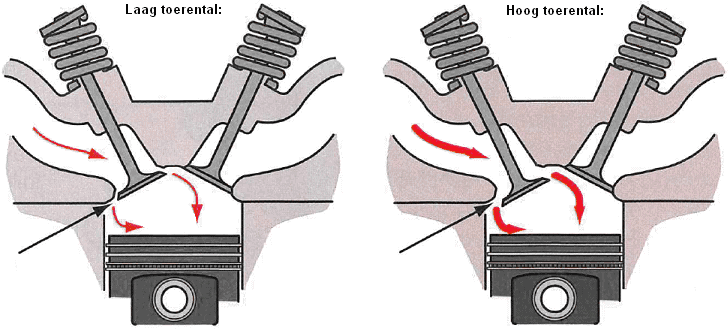
Axial shifting of the camshaft:
With this system, the camshaft is shifted longitudinally. The green part on the camshaft indicates the height of the cam at low revs and low power. On that portion, the inlet valve will not open far. The red part on the camshaft indicates the height of the cam at high revs and/or a lot of power. The valve will then open further. This system is used by Honda and is known as “V-tec”.
The camshaft is shifted because a solenoid valve supplies oil into an oil chamber.
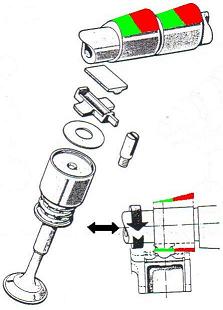
valvetronic:
The Valvetronic system from BMW makes it possible to adjust the height at which the valve is opened to the conditions of use. When the engine is idling, the valves will only open a few millimeters; due to the small air gap, the air entering the cylinders will have a high velocity. Due to the high air speed, a better vortex can also be created. Due to this vortex, the fuel mist will be better distributed, so that the combustion is optimal.
At higher speeds or higher loads, the valves will open further.
The Valvetronic system completely takes over the task of the throttle, which opens further as the speed and load increase. The throttle is therefore superfluous and not present in engines where Valvetronic is used.
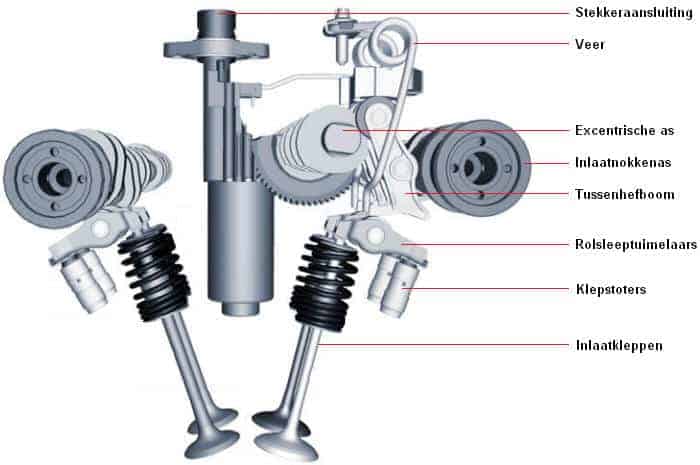
While the engine is idling, the camshaft (1) will push against the intermediate lever (2). The intermediate lever will pivot at the top about the eccentric shaft. This will cause the bottom to move to the left. Because the underside pushes the roller tow rocker (3) downwards, the inlet valve will be opened. When the camshaft is turned further and the cam is at the top, the spring (4) will push the intermediate lever back to its original position. The inlet valve closes.
At an increased speed or increased load, the electric motor will rotate the worm wheel and thus also the gear ring of the eccentric shaft (5). Because the eccentric shaft has been turned, the thick part will now turn the intermediate lever at an angle. The intermediate lever is therefore tilted. As a result, the underside of the intermediate lever will push the inlet valve roller rocker arm down a greater distance. The inlet valve will now open further.
By constantly changing the lever position on the basis of the engine speed and load, the valves will open further and less wide.
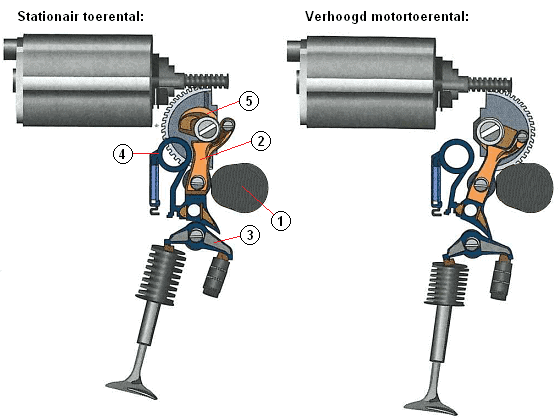
Multi Air:
MuliAir is a fully electronically controlled system for individually controlling the opening and closing of the inlet valves via an electronic-hydraulic control. With MultiAir, both the valve lift and the valve timing of the inlet valves are controlled. MultiAir is used on both petrol and diesel engines. An adjustable camshaft is no longer necessary.
With MultiAir there is a hydraulic connection between the camshaft and the inlet valve. The camshaft drives the piston of the MultiAir high-pressure cylinder via a roller rocker arm. The piston in this high-pressure cylinder forces the oil to the electronically controlled valve; also called the solenoid or solenoid valve. The oil volume passed to the oil chamber above the inlet valves is varied by the electronically controlled valve. Less oil volume means that the intake valve opens less wide. This electronically controlled valve is precisely controlled by the engine control unit (the ECU). As a result, both the timing and the lift height can be precisely adapted to the air demand of the engine.
When engine power is required, such as when driving at higher speeds and with higher engine loads, the intake valve will open fully.
During engine starting and idling, the intake valve will open later. There will be a large underpressure in the combustion chamber, which causes the air speed to increase when the inlet valve is opened. This ensures better mixture formation and better combustion.
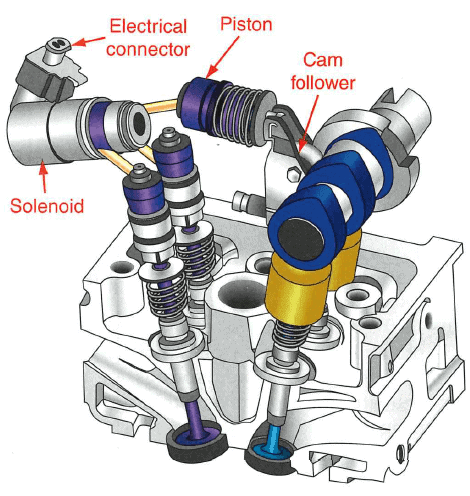
At medium revs and partial engine load, the intake valve will close earlier. This prevents interference in the intake manifold and reduces gas exchange losses, ultimately resulting in higher engine torque.
There is also a “multilift” at medium speeds and partial engine load. With multilift, the exhaust valves are opened several times per power stroke, which improves the combustion quality.
MultiAir also makes it possible to briefly open the intake valves at the end of the exhaust stroke; this adds a small portion of the exhaust gases to the intake air and creates an internal EGR.
For more explanation about valves and valve operation, see the chapters valves, valve timing en camshaft.
